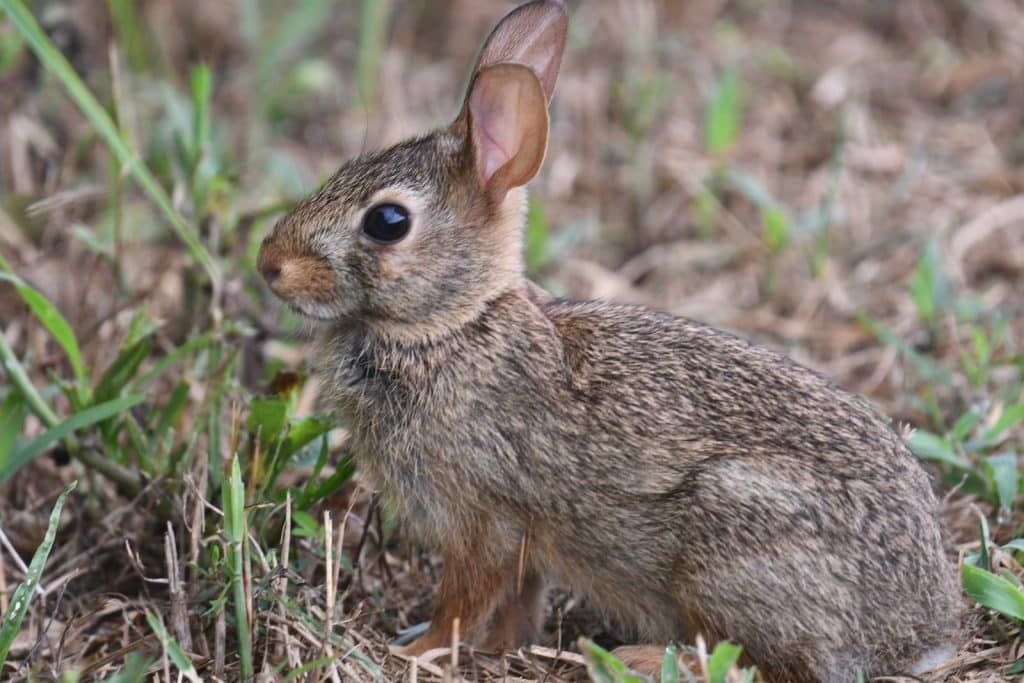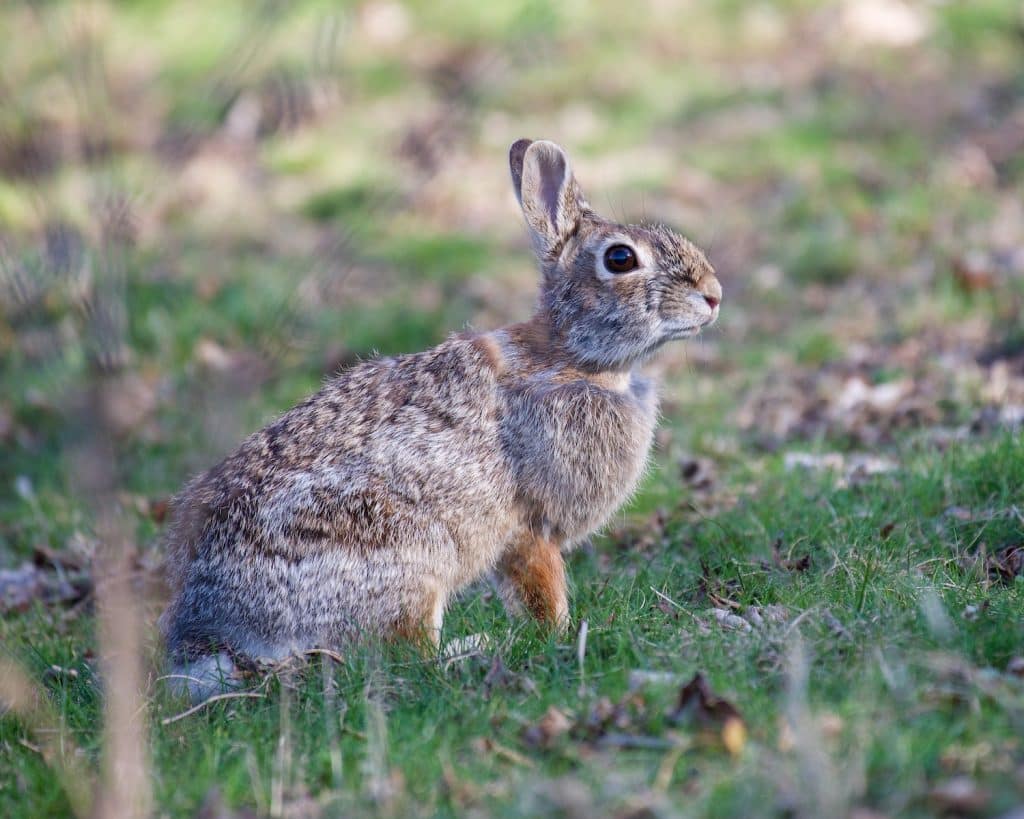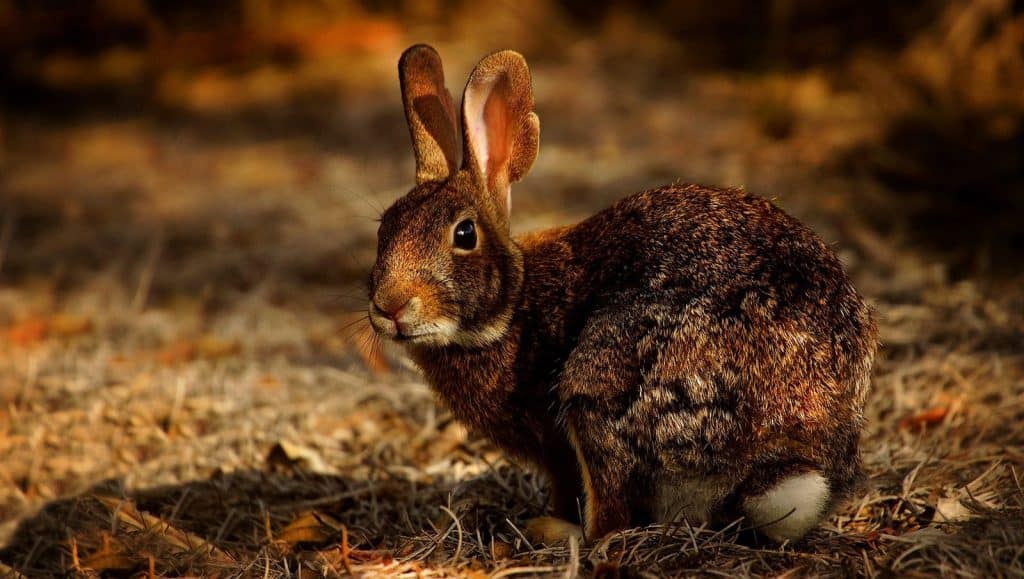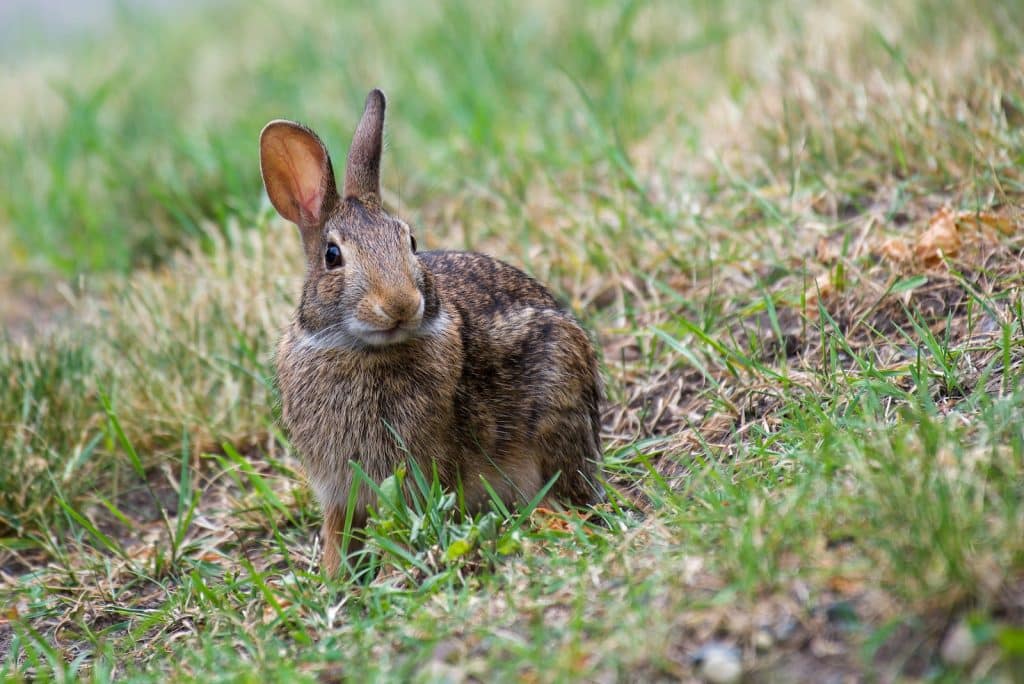
The Eastern Cottontail rabbit is the most common rabbit found in North America. You’ll usually see these rabbits in meadows, grasslands, and shrubbery in the Eastern and South-Central United States. You can also find it in Canada, Mexico, Central, and South America. Its habitat grows as foresting reduces and cuts back trees exposing more land. It has experienced rapid expansion since its introduction to Northern Italy in the mid-1960s.
Quick Facts about Eastern Cottontail
| Species Name: | S. Floridanus |
| Family: | Leporidae |
| Habitat: | Meadows, grasslands, shrubbery |
| Distribution: | Eastern US, South Central US |
| Temperament: | Wild |
| Color Form: | Red-brown, grey brown |
| Lifespan: | 2 years |
| Size: | 14 – 19 inches |
| Diet: | Bark, twigs, fruit, buds, flowers, seeds |
| Litter Size: | 2 – 8 |
Eastern Cottontail Overview
You will find the Eastern Cottontail in open grassy areas where there are shrubs or low-lying trees for cover. They like to sit in the garden if there is a garage or porch nearby where they could hide. You can also find them in fields along fences and by swamps and marshes. You usually don’t see them in deep woods or forests, and they tend to be most active at dawn and dusk.

How Much Do Eastern Cottontails Cost?
Though there are several domesticated rabbit breeds that you can keep as pets, like the Lionhead Rabbit, Flemish Giant, Holland Lop, and many others, the Eastern Cottontail is not among them. The Cottontail remains wild and will not tame despite best efforts. Therefore, there are no breeders, and you cannot buy one.
Typical Behavior & Temperament
The Cottontail Rabbit is a territorial animal that will maintain several acres. It likes to be in the open but stays within range of a hiding spot. If a predator is chasing it, it will run in a zig zap pattern toward shelter. Unlike many breeds, the Eastern Cottontail does not dig burrows. It tends to nest in short grassy depressions or under a coniferous tree but may borrow an abandoned den during heavy snow. It can sit completely still for up to 15 minutes and is most active when the light is very dim. Early morning or right before it gets completely dark is a great time to see them, and they also come out when it’s foggy or rainy.
Appearance & Varieties

The Eastern Cottontail is a mid-sized rabbit that stands between 14 and 19 inches tall. It’s usually either a reddish-brown or gray-brown color, and it has long ears and a short tail, generally with white hair on the underside giving it its telltale cottontail appearance. It can weigh between 1.5 and 4.5 pounds, and the female tends to be slightly heavier.
How to Take Care of Eastern Cottontail
While you can’t keep an Eastern Cottontail as a pet, there are some things you can do to invite them into your yard. Planting plenty of low-lying shrubbery around the edges of your home can help create an inviting atmosphere. A coniferous tree can also help, as will a well-kept yard with some running space. You should also add some signs around your property to warn traffic to slow down as traffic accidents are a leading cause of rabbit mortality. It likes to eat grasses, fruit, and several vegetables, so it will likely be attracted to a garden.
Do Eastern Cottontail Rabbits Get Along with Other Pets?
Unfortunately, the Eastern Cottontail rabbit is one of the most predated animals in the world. It makes up a large percentage of many animals’ diets, including hawks, owls, foxes, and even squirrels. Cats and dogs will readily chase them, so it’s not a good idea to have one of these animals if you want to invite Eastern Cottontail rabbits to your home.
What to Feed Your Eastern Cottontail Rabbit
Eastern Cottontail rabbits eat a large variety of plants, and there is even some evidence they will eat soft bugs on occasion. Their main diet consists of different grasses mixed with fruits and vegetables if they can find them. During the winter, it will resort to eating bark and small twigs if it can reach them. It will also eat fruits that fall from trees like apples, pears, and corn if there is any nearby. The Eastern Cottontail rabbit is one of the few animals that prefer to eat on all fours and does not use its front paws as hands except when trying to pull down a low-hanging branch.

Breeding
The breeding season is dependent on location, but it can start as early as February. Rabbits are polygamous, and one male can impregnate several females, but they will still fight for the right to be with the female. Children arrive approximately 28 days later, and the mother places them in a small nest. Baby rabbits have no fur and cannot see, but they will quickly grow and leave the nest in two weeks.
The female will begin mating again a few hours after giving birth and can give birth to three to six liters per year. Litters can be as small as two or as large as eight, but four is the average.
Are Eastern Cottontail Rabbits Suitable For You?
Unfortunately, as we mentioned earlier, you cannot tame a wild rabbit, so you can’t keep one as a pet. Several other breeds, including the Mini Rex and the Holland Lop, will make much better pets. Though you can keep an Eastern Cottontail captive, it will not become tame and may try to bite you even a year or more after you capture it. It is unlikely to be happy and may suffer from health problems due to high anxiety.
We hope you have enjoyed reading over this guide and have found the answers you needed. If you have found it helpful, please share this guide to the Eastern Cottontail rabbit on Facebook and Twitter.
Is a cottontail considered a rabbit or a bunny?
Background: Connecticut’s sole native rabbit is the New England cottontail. The eastern cottontail was introduced to New England in the late 1800s and early 1900s and has subsequently spread.
Is it possible to pet a wild rabbit?
If you, your children, or your pets witness a wild rabbit, whether living or dead, keep away from it. You may have illness signs one to 21 days after handling a wild rabbit. Tularemia is extremely infectious and more frequent in humans than in pets.
Do wild rabbits transmit diseases?
Rabbits kept outside, caught from wild populations, or purchased from a pet store may be carriers of zoonotic illnesses. Pasteurellosis, ringworm, mycobacteriosis, cryptosporidiosis, and external parasites are all zoonotic illnesses connected with rabbits.
Do wild rabbits consume water?
Rabbits can drink around 4 ounces per kilogram of body weight. As a result, most people will consume 4-8 ounces each day. It’s crucial to note, though, that rabbits obtain a majority of their water from their food. Water is found in grass, flowers, and leafy plants, which helps keep wild rabbits hydrated.
Do wild rabbits consume fruit?
Wild rabbits will consume little berries as well as other plant components to balance off the high sugar content of the fruit. If you want to feed the wild rabbits food, try different varieties of berries such as blueberries, raspberries, strawberries, and blackberries.
Cottontail rabbits are uncommon?
This once-common rabbit’s territory has diminished and its population has declined during the last 50 years. Biologists estimate that there are just about 13,000 New England cottontails left.
Can you get close to a newborn cottontail rabbit?
You and your children are welcome to look at the young bunnies but are not permitted to touch them. Return any bunnies that are picked up to the nest. A little human odor will not deter the mother from caring for her children. If the mother rabbit was clearly murdered, call a wildlife rehabilitator who can best care for the orphaned bunnies.
Scream cottontail rabbits?
They frequently produce low purring, growling, or grunting sounds when playing, breeding, or fighting. If an animal is kidnapped by a predator, it may cry loudly and shrilly. Cottontail rabbits are an essential link in the food chain and a primary prey item for many animals due to their high production rate.
Where do the majority of cottontail rabbits live?
They may be found from Canada to South America, and their distribution in the United States extends from the East Coast to the Midwest. These rabbits frequently reside on the outskirts of fields, farms, and other open places, away from densely inhabited regions. However, they may sometimes build their nests in yards and parks where there are more humans.